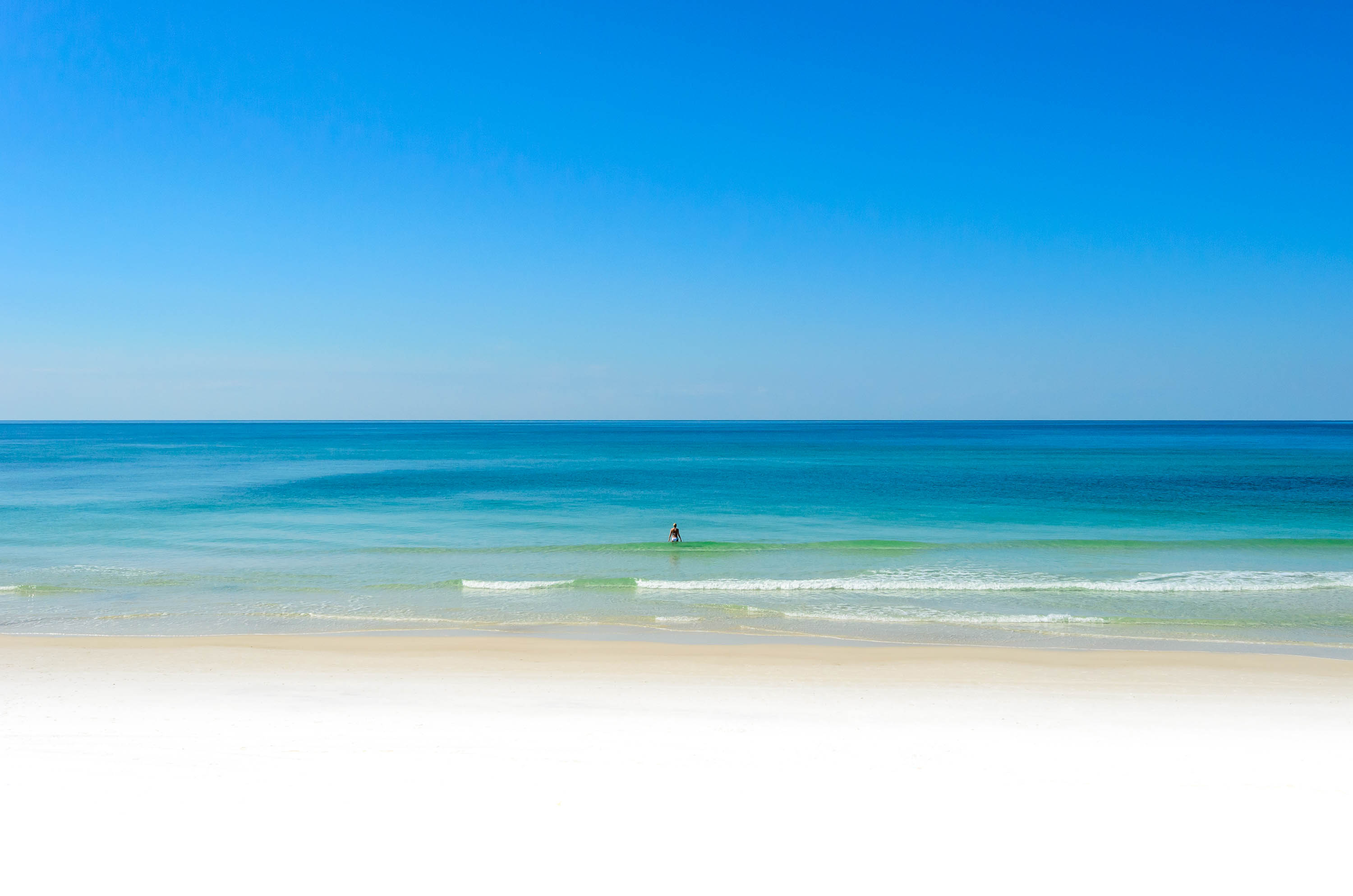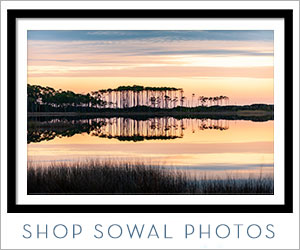Post Hurricane Ivan article
Getaway: Storm-torn Florida beaches bouncing back
By: Howard Pousner - Staff
Wednesday, October 20, 2004 Seagrove Beach, Fla. --- In June, the Clean Beaches Council honored the entire 26 miles of Walton County coastline with its Blue Wave certification --- a national stamp of approval for local efforts toward "beach sustainability."
Located in the Panhandle between Destin and Panama City Beach, Walton was the only county in the United States to have its entire shoreline celebrated with the environmental award. But locals barely had time for the good news to sink in before Hurricane Ivan paid its pummeling visit in mid-September. Ivan was brutish to those beautiful sugar-white sand beaches, which attract more than 1.3 million vacationers yearly, metro Atlantans No. 1 among them.
Especially hard hit were the towering dunes and the public walkovers that helped protect them. The hurricane left scars that government officials and private land owners began working almost immediately to begin mending. Their goal: to return the beaches to their pre-Ivan pristine state before tourism, the county's economic engine, gets humming for spring.
Even now, lodgings (some with special rates), restaurants and attractions are welcoming visitors, and many locals say the beaches, while not perfect, are fine for visitors. Officials expect Mother Nature to do her part in the healing, and it will take a lot. A loss of 20 to 30 feet in width to the dunes, most of which tower 25 to 35 feet high, was typical along the Walton County coast.
"It was though someone took a knife and cut a huge chunk out of a wedding cake," said Dave Rauschkolb, co-owner of Bud & Alley's restaurant in the architecturally renowned town of Seaside, one of 13 communities dotting the Beaches of South Walton. "But instead of a wedding cake, Ivan cut out 20 yards of bluff."
As a result, all 47 of the public beach walkovers and countless private ones were damaged or destroyed, strewing treated-lumber planks on the beach like chewed-up toothpicks tossed by the Jolly Green Giant. Twisted nails stuck out of them every which way, a siren call for tetanus shots. All 320 of the beach trash receptacles were washed out to sea. Uprooted sea oats and other natural materials clotted the shoreline.
Sand from the damaged dunes created ad-hoc mushy sandbars not far out in the surf. And the sand, which comes by its whiteness naturally, comprised as it is of 98 percent quartz, sported streaks of reddish-brown and black from minerals and vegetation roots exposed by the storm.
Brad Pickel, director of beach management for the Walton County Tourism Development Council, surveyed the toll the day after the storm hit and felt thankful that it wasn't worse. "Had the storm shifted 40 miles to the east," he said, "we would have been hit like Fort Walton Beach, with much greater damage." Like, say, at Okaloosa Island, off Fort Walton.
At the Four Points Sheraton there, more than 3 feet of sand checked into some ground-floor rooms overnight, and an estimated 50,000 cubic yards had to be extracted from swimming pools, walkways and residential areas. The Beaches of South Walton were not only saved by Ivan's landfall occurring nearly 100 miles to the west, in Gulf Shores, Ala., but also by the county's tall dunes.
The county is home to the highest gulf-front point in the United States: 61 1/2 feet above sea level at Blue Mountain Beach. And protecting its duneline has been one of the Tourism Development Council's major objectives since its 1986 founding; 2 cents of a 3-cents-on-the-dollar bed tax is committed to beach improvement and nourishment (the third cent is designated for marketing).
No surprise then that some of the first repairs undertaken once the storm cleared were to the 47 public beach walkovers and accesses, at an estimated cost of $3.5 million. Eight accesses are already open, and Pickel expects repairs to be complete on most of the rest by late November. With the
Federal Emergency Management Agency increasing its commitment on designated repair costs just last week --- from 75 percent to 90 percent --- the state and county will now pay 5 percent each. Total cost estimates are still being computed. Debris removal has also begun, employing bulldozers, front-end loaders and off-road dump trucks that haul the trash to staging areas where even larger dump trucks are filled.
The process, which will entail three complete pass-throughs of the coastline (except for stretches controlled by state parks), is expected to be completed by mid-November. The rebuilding of eroded dunes will be a collaboration between nature, the public sector and private owners.
The wind is already doing its part, blowing sand ashore that dries and is eventually swept onto the dunes. Though Ivan stripped many dunes of their sea oats, their spiderweblike roots will soon start sending out new shoots that will serve as a framework for growth.
These natural efforts will be supplemented by workers placing sand at the toe of the existing dunes and planting those areas with stabilizing native vegetation including sea oats, panic grass and saltmeadow cordgrass, Pickel said.
"It's a very expensive process," Pickel acknowledges. "The estimates we're getting are $25-$30 per cubic yard of sand put in place." Private property owners are coordinating similar efforts, some of which will be underwritten with FEMA funds. Seaside plans to replenish its "strong, town-saving dunes" with an additional 40,000 cubic yards of sand, said marketing manager Frank Berte. Estimated cost: $750,000.
To the west, Sandestin Golf and Beach Resort opened a temporary beach access the week after the storm and is planning an enhanced replacement walkover, said marketing director Zandra Wolfgram. Work to replenish 450 feet of dunes, with 7,000 to 9,000 cubic yards of sand and sea oats, is under way.
Despite all the labor still to be done, locals who've weathered many a storm prior to Ivan claim the water's just fine (at least for dipping toes in surf). "We've always laughed about it, saying hurricanes are Mother Nature's way of cleansing things," said William Schissler, owner of Frank's Cash and Carry, a Grayton Beach hardware store (its second location, inland at Freeport, has a lumberyard that's provided materials for many of the walkover repairs).
"I took a lunch break just yesterday and sat on the beach awhile. The water was clear, the sand was nice. It's really hard to tell [Ivan visited] except that the dunes are flatter." Like Schissler, Bud & Alley's co-owner Rauschkolb rode out the storm. Instead of bunking at his home in Rosemary Beach, he rented a place atop a four-story concrete structure in Seaside where he could keep an eye on his restaurant and its rooftop bar overlooking the Gulf, the Tarpon Club. "In case Bud & Alley's washed away, I wanted to watch her go," explains Rauschkolb, who even bought a video camera to document it all.
"After 19 years, that would've been poignant." But after Ivan put on its power show, he said he felt much better than he did after Hurricane Opal in 1995. "After Opal, I felt the sort of way I felt after 9/11 --- like a zombie, deep in despair." The difference?
"This time, I knew what to expect. I knew the beaches would be damaged but would come back," Rauschkolb said. "For the last four weeks, I've done everything I can to assure as many people as possible, 'You really don't need to worry . . .' Within six months, the dunes will be as beautiful as ever. They'll be different, sure, but beautiful nonetheless."
Getaway: Storm-torn Florida beaches bouncing back
By: Howard Pousner - Staff
Wednesday, October 20, 2004 Seagrove Beach, Fla. --- In June, the Clean Beaches Council honored the entire 26 miles of Walton County coastline with its Blue Wave certification --- a national stamp of approval for local efforts toward "beach sustainability."
Located in the Panhandle between Destin and Panama City Beach, Walton was the only county in the United States to have its entire shoreline celebrated with the environmental award. But locals barely had time for the good news to sink in before Hurricane Ivan paid its pummeling visit in mid-September. Ivan was brutish to those beautiful sugar-white sand beaches, which attract more than 1.3 million vacationers yearly, metro Atlantans No. 1 among them.
Especially hard hit were the towering dunes and the public walkovers that helped protect them. The hurricane left scars that government officials and private land owners began working almost immediately to begin mending. Their goal: to return the beaches to their pre-Ivan pristine state before tourism, the county's economic engine, gets humming for spring.
Even now, lodgings (some with special rates), restaurants and attractions are welcoming visitors, and many locals say the beaches, while not perfect, are fine for visitors. Officials expect Mother Nature to do her part in the healing, and it will take a lot. A loss of 20 to 30 feet in width to the dunes, most of which tower 25 to 35 feet high, was typical along the Walton County coast.
"It was though someone took a knife and cut a huge chunk out of a wedding cake," said Dave Rauschkolb, co-owner of Bud & Alley's restaurant in the architecturally renowned town of Seaside, one of 13 communities dotting the Beaches of South Walton. "But instead of a wedding cake, Ivan cut out 20 yards of bluff."
As a result, all 47 of the public beach walkovers and countless private ones were damaged or destroyed, strewing treated-lumber planks on the beach like chewed-up toothpicks tossed by the Jolly Green Giant. Twisted nails stuck out of them every which way, a siren call for tetanus shots. All 320 of the beach trash receptacles were washed out to sea. Uprooted sea oats and other natural materials clotted the shoreline.
Sand from the damaged dunes created ad-hoc mushy sandbars not far out in the surf. And the sand, which comes by its whiteness naturally, comprised as it is of 98 percent quartz, sported streaks of reddish-brown and black from minerals and vegetation roots exposed by the storm.
Brad Pickel, director of beach management for the Walton County Tourism Development Council, surveyed the toll the day after the storm hit and felt thankful that it wasn't worse. "Had the storm shifted 40 miles to the east," he said, "we would have been hit like Fort Walton Beach, with much greater damage." Like, say, at Okaloosa Island, off Fort Walton.
At the Four Points Sheraton there, more than 3 feet of sand checked into some ground-floor rooms overnight, and an estimated 50,000 cubic yards had to be extracted from swimming pools, walkways and residential areas. The Beaches of South Walton were not only saved by Ivan's landfall occurring nearly 100 miles to the west, in Gulf Shores, Ala., but also by the county's tall dunes.
The county is home to the highest gulf-front point in the United States: 61 1/2 feet above sea level at Blue Mountain Beach. And protecting its duneline has been one of the Tourism Development Council's major objectives since its 1986 founding; 2 cents of a 3-cents-on-the-dollar bed tax is committed to beach improvement and nourishment (the third cent is designated for marketing).
No surprise then that some of the first repairs undertaken once the storm cleared were to the 47 public beach walkovers and accesses, at an estimated cost of $3.5 million. Eight accesses are already open, and Pickel expects repairs to be complete on most of the rest by late November. With the
Federal Emergency Management Agency increasing its commitment on designated repair costs just last week --- from 75 percent to 90 percent --- the state and county will now pay 5 percent each. Total cost estimates are still being computed. Debris removal has also begun, employing bulldozers, front-end loaders and off-road dump trucks that haul the trash to staging areas where even larger dump trucks are filled.
The process, which will entail three complete pass-throughs of the coastline (except for stretches controlled by state parks), is expected to be completed by mid-November. The rebuilding of eroded dunes will be a collaboration between nature, the public sector and private owners.
The wind is already doing its part, blowing sand ashore that dries and is eventually swept onto the dunes. Though Ivan stripped many dunes of their sea oats, their spiderweblike roots will soon start sending out new shoots that will serve as a framework for growth.
These natural efforts will be supplemented by workers placing sand at the toe of the existing dunes and planting those areas with stabilizing native vegetation including sea oats, panic grass and saltmeadow cordgrass, Pickel said.
"It's a very expensive process," Pickel acknowledges. "The estimates we're getting are $25-$30 per cubic yard of sand put in place." Private property owners are coordinating similar efforts, some of which will be underwritten with FEMA funds. Seaside plans to replenish its "strong, town-saving dunes" with an additional 40,000 cubic yards of sand, said marketing manager Frank Berte. Estimated cost: $750,000.
To the west, Sandestin Golf and Beach Resort opened a temporary beach access the week after the storm and is planning an enhanced replacement walkover, said marketing director Zandra Wolfgram. Work to replenish 450 feet of dunes, with 7,000 to 9,000 cubic yards of sand and sea oats, is under way.
Despite all the labor still to be done, locals who've weathered many a storm prior to Ivan claim the water's just fine (at least for dipping toes in surf). "We've always laughed about it, saying hurricanes are Mother Nature's way of cleansing things," said William Schissler, owner of Frank's Cash and Carry, a Grayton Beach hardware store (its second location, inland at Freeport, has a lumberyard that's provided materials for many of the walkover repairs).
"I took a lunch break just yesterday and sat on the beach awhile. The water was clear, the sand was nice. It's really hard to tell [Ivan visited] except that the dunes are flatter." Like Schissler, Bud & Alley's co-owner Rauschkolb rode out the storm. Instead of bunking at his home in Rosemary Beach, he rented a place atop a four-story concrete structure in Seaside where he could keep an eye on his restaurant and its rooftop bar overlooking the Gulf, the Tarpon Club. "In case Bud & Alley's washed away, I wanted to watch her go," explains Rauschkolb, who even bought a video camera to document it all.
"After 19 years, that would've been poignant." But after Ivan put on its power show, he said he felt much better than he did after Hurricane Opal in 1995. "After Opal, I felt the sort of way I felt after 9/11 --- like a zombie, deep in despair." The difference?
"This time, I knew what to expect. I knew the beaches would be damaged but would come back," Rauschkolb said. "For the last four weeks, I've done everything I can to assure as many people as possible, 'You really don't need to worry . . .' Within six months, the dunes will be as beautiful as ever. They'll be different, sure, but beautiful nonetheless."
Last edited:
















